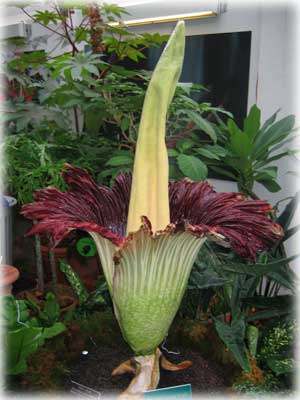 By B. BLAIR DEDRICK Scripps Howard Foundation Wire November 22, 2005
"Rotten fish," said Emily Hawver, 7, who came from Annapolis, Md., with her sister Abby, 10, and plant-enthusiast mother Janice, 44. "I didn't really get a whiff when I was smelling it, but eventually this huge smell of rotten fish came up."
Sandra Brown, 60, and her sister, Ann Davies, 52, dropped by the Botanic Garden last week, not expecting to see the massive plant - known scientifically as Amorphophallus titanium and commonly as "corpse plant" - but they were excited even though it was not blooming yet then. "It's one of these things that you might never see again," said Brown, an ecologist with Winthrop International, a nonprofit environmental group. "This big stinky thing - it's an unusual event." The plant, owned by the Smithsonian's National Museum of Natural History, is on display at the Botanic Garden. By bloom time about 9:30 p.m. Saturday, after the Botanic Garden was closed to visitors, the plant was 52-1/2 inches tall. Many of those who worked with the plant were on hand for what became a blooming party, watching the bloom unfold while sipping wine. One even came from the theater to see the botanical superstar. "You could actually see it twitching open," said Michael Bordelon, greenhouse collections manager for the Natural History Museum. He and many of the others stayed until after midnight. Six thousand people turned out Sunday, and despite a steady rain, the flow hadn't abated on Monday when the blossom was visibly fading. Two years ago, when a different titan arum bloomed at the height of the summer tourist season, Botanic Garden officials said 70,000 visitors came through. "Freak shows have always been popular," said W. John Kress, chairman of the botany department at the Natural History Museum and an expert on the Araceae plant family, to which the smelly plant belongs. "Like the panda, it represents nature in a fabulous, exciting way. It becomes an icon for what nature is about." Christine A. Flanagan, Botanic Garden public-programs manager, had a different explanation. "There is so much bad news, people want to see something that is frivolous," she said. "And, it's big." Dan Nicolson is a curator of the botany department at the Natural History Museum and one of the world's leading experts on the Araceae plant family. "It smells like dead rat. Mmmm," he said, grinning as he explained that the smell attracts carrion beetles and flies that are "very disappointed" because a plant "really isn't what they expected." The insects lay their eggs in rotting meat. In the wild, the insects are temporarily trapped inside the large blossom, which is made up of thousands of tiny flowers. When the pollen-dusted beetles and flies crawl out of the blossom, they fly off and fertilize another odoriferous blossom. Since the plants can't pollinate themselves, and there are only about a dozen in cultivation in the United States, pollinating the titan arum gets a bit tricky. The answer, however, was in Botanic Garden Director Holly Shimizu's refrigerator. She had pollen gathered from the titan arum that bloomed two years ago - some frozen, some refrigerated. Experts pollinated the plant with the old pollen Sunday, hoping to produce seeds.
Publish A Letter on SitNews Read Letters/Opinions Submit A Letter to the Editor
|
||
